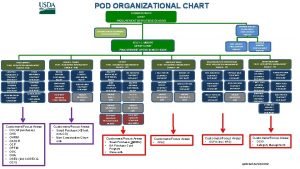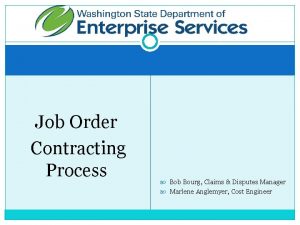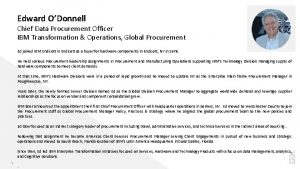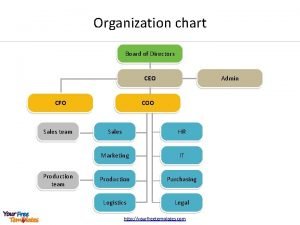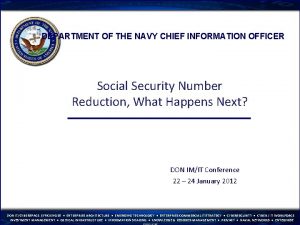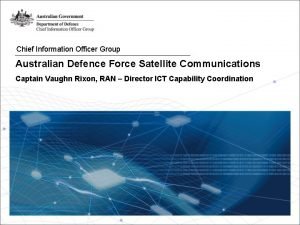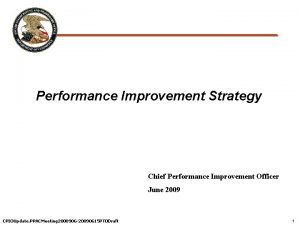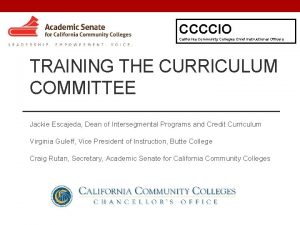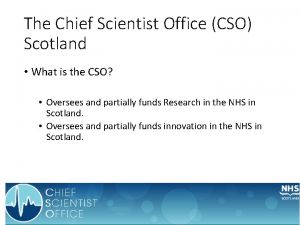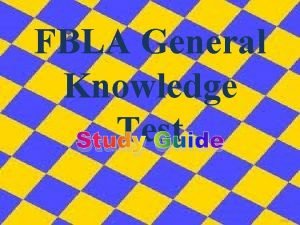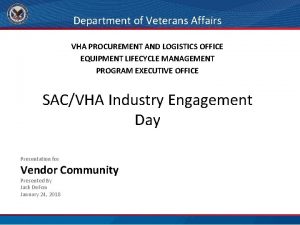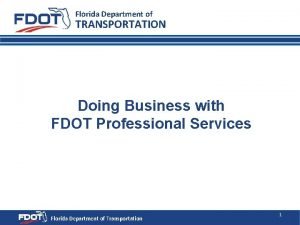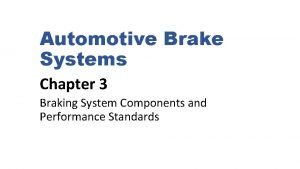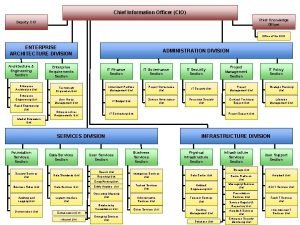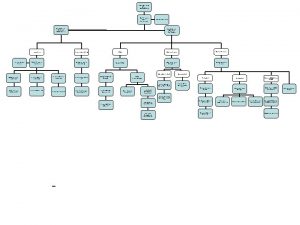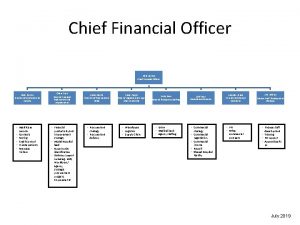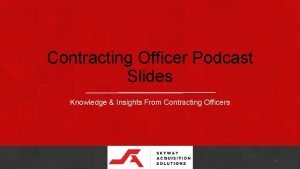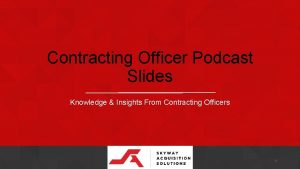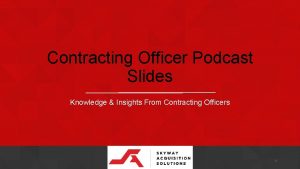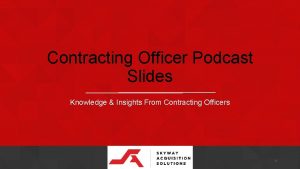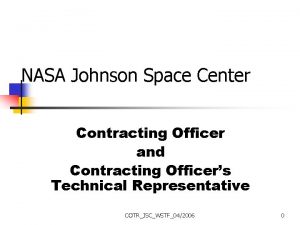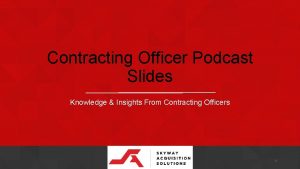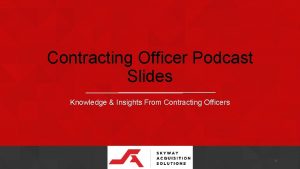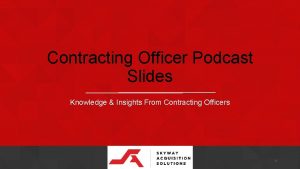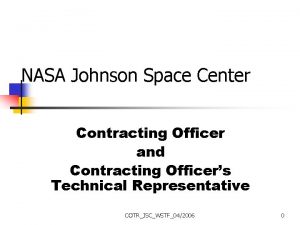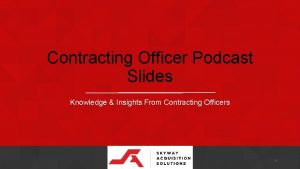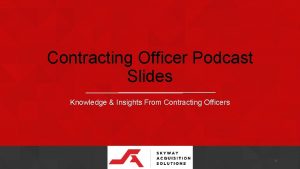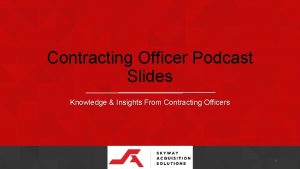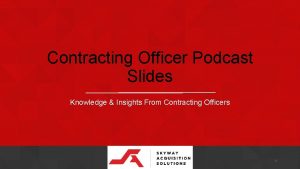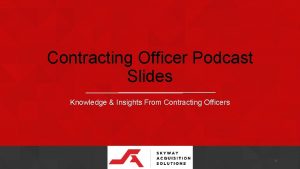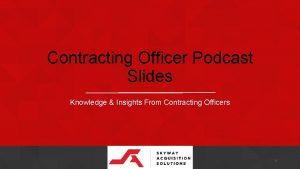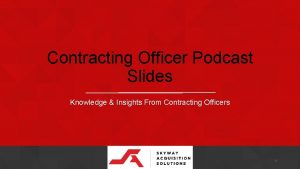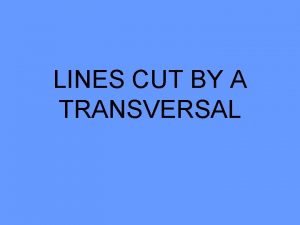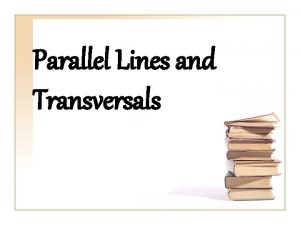TRANSVERSAL CONTRACTING Office of the Chief Procurement Officer





























- Slides: 29

TRANSVERSAL CONTRACTING Office of the Chief Procurement Officer National Treasury of South Africa Molefe-Isaac Fani Chief Director Pre-Conference Presentation - CIGFARO 06 October 2019

TRANSVERSAL CONTRACTING 1. Public Procurement in Context 2. Transversal Sourcing – A solution 3. Candide reflection of ourselves – where are we now? 4. Where are we going? The road ahead 5. Journey Evaluation – Are we there yet? 6. Questions Transversal Contracting 2

Public Procurement in Context

Public Service Procurement v The Public sector is the country’s single largest service provider. An incremental improvement in public service delivery positively impacts millions of people. More than R 600 Billion Spend per annum. v Beyond advancing social objectives, public procurement in South Africa is also being leveraged towards generating employment, enhancing domestic manufacturing capacity, and supporting inclusive growth priorities. 4

Public Service Procurement To support the overall goals of public service procurement, delivery must be clearly understood. That means, using the public money effectively will enable government to: v v Improve service delivery for citizens Defeat inequality Create jobs; and Give value for money for purchases 5

Leveraging on Public Procurement - wins • Service delivery; – Quality, efficient, cost-effective – On time, right quality and quantity, the right price • Socio-economic objectives; – Address economic imbalances – Women, youth, people with disabilities, SMMEs – Job creation • Value-for-money and return on investment; • Getting the balance between the objectives is important 6

Problem statement 7

Problem Statement Some of the challenges identified in the procurement value chain: need for transversal contracts: • A fragmented approach to planning and procurement and/or lack of systematic replenishment and replacement strategy • Inconsistencies in prices between private and public sector and between provinces exist for goods and services • The rapid rate of technological influx and lack of a scientific mechanism to decide on appropriate technologies • Poor maintenance practices with a high percentage of equipment that is not fully functional and high levels of maintenance backlogs coupled with low user training levels • Lesser control and monitoring capability, increased levels of corruption and abuse of the system, not realizing benefits from leveraging on economies of scale, poor inventory management. 8

Expanded Problem statement • Fragmented procurement system across the State • Lengthy tender processes – 6 months to a year to finalise a tender • Huge price variations between procuring entities • Poor standardisation in procuring same goods/ services/ works • Lack of focus on core service delivery • Lack Procurement planning • Over-use of RFQ methods • Inadequate Procurement Capacity • Manual Procurement System • Lack of Self-Monitoring Culture • Weak contract management • Unnecessarily appeals and judicial review process • Interference • Tenderpreneurism • Lack of capacity to conduct monitoring and compliance • Shoddy quality/workmanship in products/ • Duplication of effort - RFx’s, Contract creation, Contract management, Supplier queries, Litigation, Cancelled tenders and contracts, Audit queries services 9

Impact: delayed service delivery 10

Consequences: service delivery collapse 11

Transversal Sourcing – A solution

Legal Framework on Transversal Term Contracts • Transversal contracts are facilitated by: – National treasury – Provincial Treasuries – other than NT transversal contracts • • Applicable to: – All Departments, National and Provincial – Constitutional and public entities as listed in schedule 2 and 3 to the PFMA – SOE may participate – Municipalities may participate (Regulation 32 of MFMA) Transversal contracts provides for the following: – Voluntary participation in Contracts arranged by relevant Treasuries – Prohibition of facilitation of Transversal Term Contracts by other organs of state but the relevant treasuries

Transversal contracting • Over R 25 Billion spend per annum under central management • Currently, the National Treasury manages 65 transversal contracts for the purchase of goods and service 14

Scope of centrally negotiated contracts • Reduce cost and Increase value • How? Leverage economies of scale • Departments, provinces, municipalities and entities are procuring from central contracts. • These centrally negotiated contracts: – Eliminate unnecessary duplication, reduce leakage and ensure better use of scarce procurement skills – Reduce the administrative burden for suppliers – Provides an opportunity for long-term supplier relationships and certainty in the market place – Better market intelligence across government – Reduce the administrative burden from repetitive quotes which could have been directed towards contracts; and – Allow government to refocus on contract management 15

Candide reflection of ourselves – where are we now?

The current TC environment

Current SCM challenges PROCESS • • • Intensive Labour demand management process Paper based submissions leads to long bid management process Limited alignment between people, process and system Paper based process leads to long contracting lead times Lack of visibility on consumption / forecasting leads to incorrect contract values “Red tape” delays contract throughput Multiple extensions on contracts due to slow processes Payments against contract not honoured Weak contract management and supplier relationship processes PEOPLE • • • Inadequate knowledge of new commodities Inadequate capacity to drive the annual spend Resistance to adoption of new technology / processes Buy-in from client Departments not always there Staff not catching “the dream” (tactical vs strategic) Skills and capacity gaps in current personnel ORGANISATION • • Inadequate stakeholder engagement The current organisation structure does not necessarily support the growth path envisaged SYSTEMS • • Current systems not performing optimally Limited utilisation of system functionality Numerous processes not performed in system ie. CPA, contract management, etc Paper based process to be replaced by system functionality

Where are we going? The road ahead

Sourcing diagnostic and process enhancement 1. Assess opportunity 6. 2. Implement Sourcing Decisions Define Internal requirements 3. 5. Assess External Supply Market Execute Sourcing Strategy 4. Develop Sourcing Strategy 20

Evaluate Ideas Cost saving ideas Idea prioritisation matrix R 100 m Competitive Bidding 1 3 Long term high value projects Star ideas- pursue immediately Rationalise current specifications 2 Ideal value 4 3 Implement new corporate requirements 4 Reduce procurement, labour and admin costs 1 Last priority 2 Quick-wins R 0 m Low (Difficult) High (Easy) Ease of implementation

Negotiation Power Level of Impact Potential Competitive forces Bargaining power of Suppliers Rationale Low High • Many suppliers • Quality of supply is a key factor • High level of disengaging Threat of New Entrants Low High • Low entry requirements • Low to medium capital outlay • Low and medium regulated industry Bargaining power of Buyer Low High • Significant annual spend – largest market buyer • Product/ service for the majority of Departments critical for service delivery Threat of Substitutes Competitive Rivalry Low High • Low, if done, not a threat • Level of manufacturing in SA low • Aggressive price competition • Open trade markets allowing participation by multinationals Negotiation Power Balanced 22

Savings Approaches • • • • • Supplier rationalisation Increase supply base Reduce Volumes Volume pooling Volume redistribution Category consolidation Stadardisation • • Renegotiate contracts Bundling & Un-bundling Current Market Reverse engineering Reverse Auctions Internal price benchmarking Transportation / packaging Exchange Rate Indexing or Hedging Formula Pricing Fixed Pricing Lowest quoted price or lowest cost Competitive bidding Develop long-term contracts Analyze core competencies Examine make versus buy decisions Networking Once off vs strategic partnerships • • Identify global suppliers for the Commodity group • Market protection • • Supply chain integration Consignee stock and supplier maintenance Simplified ordering Joint improvement opportunities Outsourcing and Insourcing Optimize communication Strategic alliance Rationalise / Standardise Piece part of assembly Consulting or engineering standards Product or part substitution Concurrent production Value engineering Examine life cycle cost Develop long-term contracts

Ease of Strategy Implementation Ease of Implementation Easy Demand Volume Management Concentration • Supplier rationalisation • Increase supply base Reduce Volumes Volume pooling Volume redistribution Category consolidation Standardisation • • • Actions • Policy changes that reduce demand for the product/ service or substitute lower price product/ service • • • • Difficult Best Price Global Product Specs Joint Process Relationships Evaluation Sourcing Improvement Restructuring Renegotiate contracts Bundling/Un-bundling • Current Market Reverse engineering • Reverse Auctions Internal price benchmarking Transportation / packaging Exchange Rate Indexing or Hedging Formula Pricing Fixed Pricing Lowest quoted price or lowest cost Competitive bidding Develop long-term contracts Typical Focus for Initial Efforts Identify global suppliers for the Commodity group Market protection • Rationalise / Standardise • Piece part of assembly Consulting or engineering standards Product or part substitution • • • Concurrent production Value engineering Examine life cycle cost Develop longterm contracts • Supply chain integration • • Analyze core competencies Consignee stock and supplier maintenance Simplified ordering Joint improvement opportunities Outsourcing and Insourcing Optimize communication Strategic alliance • Examine make versus buy decisions • • •

Quantify benefits at three relationship levels • • NATIONAL • • Consistency in policy application and effective contract management Negotiate better prices based on bulk buying Market intelligence can be shared across public sector and maintaining sustainable competition Scarce procurement skills are better utilized • • • INDUSTRY • Less administration burden Enable suppliers to negotiate better prices for the materials/products manufactures Opportunity for improved distribution planning Managing business risk i. e. forex exchange fluctuations TREASURY ENDUSERS • • Access to products and availability (Right products delivered in full and on-time) Quality products and service delivery Less administration burden Close monitoring and reporting on supplier performance 25

Journey Evaluation - Are we there yet?

Key Results Efficient Procurement Management Low internal administrative cost for institutionallevel services Improve quality of services Key Results Realisation of targeted saving based on current spend portfolio Lowered cost for suppliers Leverage category spend across all departments 27

Performance Measures (have we arrived yet? • • Significant reductions in prices of goods and services due to economies of scale; Better services at lower cost; • Increased purchasing power for Government; • Technical standardisation for government procurement; • Better performance management of staff; and • Effective contract management and controls, clean audit trail • Increased capacity by line Departments to focus on core • • • Achieve savings as a result of participation by organs of state Increase participation by Local Government and State Owned Entities Increase in Local, Black and Small Business Spend Respond to empowerment of women Respond to local economic development initiatives at provincial and municipal levels 28

The end – Thank you Any questions? 29
 Chief contracting officer
Chief contracting officer Nyu procurement org chart
Nyu procurement org chart Office of the government chief information officer
Office of the government chief information officer Usda office of the chief financial officer
Usda office of the chief financial officer Contracting officer podcast
Contracting officer podcast Procurement transformation contracting
Procurement transformation contracting Lesson 3 commander in chief and chief diplomat
Lesson 3 commander in chief and chief diplomat Adolfo gonzales chief probation officer
Adolfo gonzales chief probation officer Chief accountability officer
Chief accountability officer Chief data officer training
Chief data officer training Ibm chief data officer
Ibm chief data officer Alexander kjerulf happiness at work
Alexander kjerulf happiness at work Chief csr officer
Chief csr officer Struktur ceo
Struktur ceo Department of the navy chief information officer
Department of the navy chief information officer Chief reality officer
Chief reality officer Defence ciog org chart
Defence ciog org chart Chief improvement officer
Chief improvement officer Capitalize chief executive officer
Capitalize chief executive officer Ccccio website
Ccccio website Chief knowledge officer job description
Chief knowledge officer job description Chief turnaround officer
Chief turnaround officer Chief scientist scotland
Chief scientist scotland What was the first fbla state chapter
What was the first fbla state chapter Vha procurement and logistics office
Vha procurement and logistics office Fdot selection results
Fdot selection results The external contracting brake
The external contracting brake Universal fencing contracting
Universal fencing contracting Contracting 101 presentation
Contracting 101 presentation Brake system components
Brake system components

